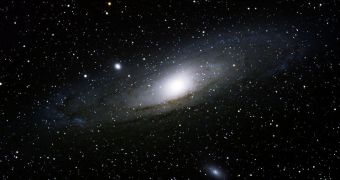Astronomers analyzing the Milky Way have many years ago observed the existence of a thick disk of stars in its central regions, in addition to the thin disc that makes most of the galactic body. However, a similar structure was not found in the Andromeda Galaxy, our closest neighbor.
Experts have been looking for a thick disk on Andromeda (Messier 31) because this galaxy is very close by, which would enable our telescopes to catch a glimpse of it.
In the case of the Milky Way, the so called thick disk is made up of a population of older, iron-poor stars, whose paths taken them in a halo that extends both above and below the regular thin disk.
Telescopes trained on M31 found the think disk in our neighbor, but failed to discover the thick one. Now, scientists believe they may have a developed an explanation for why this difference between the two galaxies exist.
In past experiments, it was proposed that the thick disks were in fact a product of extensive galactic mergers, or of accretion processes through which large galaxies such as our own engulf smaller ones.
But, while this could indeed account for the presence of the thick disk in the Milky Way, it stands against its absence in Andromeda. Studies have shown that M31 has a rich history of mergers.
One of the main issues with conducting this line of investigations is angle. Researchers say that Andromeda may indeed have a thick disk, but add that its orientation towards the Milky Way does not make for a good vantage point from Earth.
In order for our telescopes to become capable to observing such structures in other galaxies, the cosmic structures need to be oriented edge on as viewed from here, Universe Today reports.
At this point, Andromeda is oriented at an angle of about 77° on the sky, given that 90° means being edge on. This makes it tremendously difficult even for professional astronomers to determine the existence or absence of the thick disc.
One interesting thing to note about Andromeda and the Milky Way is that the two galaxies, both very large and scarred by past mergers, will eventually merge with each other, in about 2 billion years.
They will form a supermassive galaxy as they put their matter together, triggering massive waves of stellar formation in areas where gas clouds meet up and collide with each other.
The large black holes at the two galactic centers will most likely come together as well, triggering the formation of a new, supermassive black hole, that will release vast amounts of radiation in the Universe.

 14 DAY TRIAL //
14 DAY TRIAL //